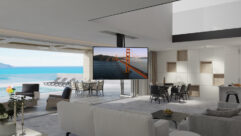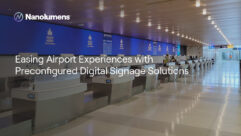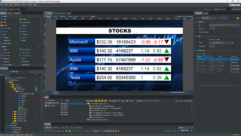
The Buzz: Installation Spotlight: General Mitchell Airport, Milwaukee
Jun 1, 2007 12:00 PM,
By Trevor Boyer
Nonstop Digital Signage

General Mitchell Airport in Milwaukee recently replaced its plasma flight information displays with NEC LCD screens to reduce burn-in and counter glare created by the airport’s open-window ceiling architecture.
Last June, General Mitchell Airport in Milwaukee replaced almost all of the 45 plasma screens that displayed its flight information with LCD screens. The airport’s maintenance department makes recommendations in such situations and installs the new AV technology itself.
The original 45 plasma screens were installed in 2001 and 2002, but by last year, the maintenance department decided those screens needed to be upgraded as part of a general expansion of flight information signage around the airport. Initially the plasma screens had all been clustered in a central area near the food court, but the airport wanted to expand that coverage to three concourses of the single domestic flights terminal. Therefore, last year, it spent around $300,000 to install 90 NEC MultiSync 4610BK LCD screens at the facility.
(There are also monitors throughout the airport that show CNN and other TV content, separate from the flight information-related digital signage network, that the maintenance department looks after as well.)

Also part of the new expanded flight information system is a graphical display of planes’ progress across a map of the United States created by FlightView Dispatch software.
For the changeover, the airport’s maintenance department specified LCD screens from NEC for several reasons. For one thing, officials were confident that the LCD screens would provide a long life expectancy — an important consideration, considering the nature of the application. Wilfredo Rivera, the maintenance department’s network specialist, says the airport got good operational life out of the older plasma screens now being replaced, and continuing that durability was an important consideration.
But, besides longevity issues, perhaps the most important reason for the change was the new screens’ standard anti-burn-in feature, which is crucial for displaying largely static flight listings.
Also, the price was right for the airport’s budget. Another important requirement for the facility’s display technology was glare reduction.
“Before, when we had the plasmas, we were getting complaints about people not being able to view the information properly because of the glaring,” Rivera says. “The way the terminal is configured, it’s basically a huge open-window ceiling where the sun literally hits all over the area.”
The NEC LCD screens address this problem with an anti-glare coating, which eliminates most of the glare that natural light creates.
A few NEC 4200BK plasmas remain, but for the most part, the transition is complete.
General Mitchell licenses software from Com-NetSoftware Solutions of Miamisburg, Ohio, to run the displays’ main functions. That includes the display of gate information for arrival and departure and baggage information for arriving flights. FlightView Dispatch software also takes information from the Federal Aviation Administration (FAA) and converts it into a graphical display of the plane (identified by its flight number) as it makes progress across a map of the United States.
The 100 flatscreens in the flight information network are each served by an HP small-form-factor workstation, and each of those is connected to three HP ProLiant DL350 servers. The digital signage network is connected via fiber.
“When we set up the system in 2002, we also invested money in creating a huge network backbone utilizing fiber, and that’s how those displays are communicating to the main head-end network,” Rivera says. He adds that a traditional network based on a telephony infrastructure with distribution amplifiers would have been too expensive and that fiber delivers a better picture.
The airport has plans to show movies and other video on the LCD displays, serving content from the HP ProLiant servers. The facility also might decide to use the flight information signage network as a platform for commercial advertising in the future, but for now, the network’s primary function is to display clear flight information for the travelers passing through the airport each day.
SUBSCRIBE TO SOUND & VIDEO CONTRACTOR E-NEWSLETTERS!
- Sound & Video Contractor EXTRA
Systems Integration Special Focus series:
- Houses of Worship
- Corporate AV
- Residential AV
- AV Over Fiber
- AV in Education
Breaking industry news in your email inbox every other week!
Subscribe atwww.svconline.com










